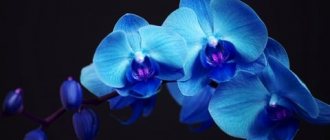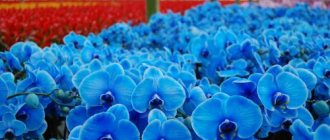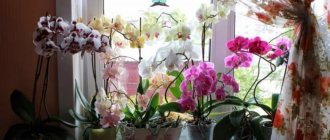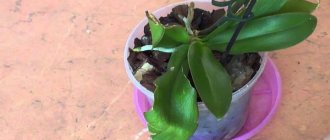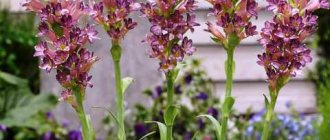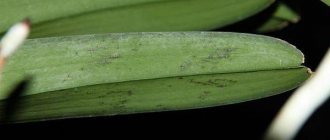Plant life cycle
The life cycle of an orchid consists of two phases - growth and dormancy . The duration of these phases depends:
- from the orchid variety;
- from living conditions;
- from selected care.
The better the care, the better the orchid will develop and grow.
After the new shoot has fully developed, the plant goes into dormancy, here growth buds appear, in some cases, flower buds may even appear. After this process is completely completed, the plant again enters the growth phase.
The life cycle of a plant directly depends on the condition of the leaves, as they play an important role in metabolism.
The water-salt balance depends on them, they also help moisture evaporate and receive nutrients and minerals from the soil. In addition, without leaves, photosynthesis and plant respiration could not be possible.
Why do orchids need a pseudobulb?
The main function of false bulbs is to accumulate nutrients. This is a “life preserver” that helps the plant survive in extreme conditions. After all, this structural feature of the orchid is due to the alternation of too dry and too wet seasons, characteristic of the places where many epiphytes grow. At home, when the flowers are given decent care, the functionality of the pseudobulb decreases. However, this organ is not at all useless: it is responsible for the reasonable use of nutrients, which should be enough for both good growth and lush flowering.
False bulbs can be formed by one internode (like oncidium) or several thickened ones (like dendrobium).
Photo
In the following photo you can see what the foliage of the plant looks like:
Orchid flowers
Orchids have gained incredible popularity due to the beauty of their flowers. The variety of their shapes and colors is truly amazing. Just look at the value of miniature flowers up to a few millimeters in size! Or powerful colorful flowers up to 25 cm in diameter! These plants differ from each other by the nature of their flowering. There are single-flowered orchids (Paphiopedilum) and multi-flowered ones (Phalaenopsis).
The structure of an orchid flower
A distinctive feature of the structure of an orchid flower is symmetry.
The flower has 3 sepals (sepals) and 2 petals (side petals), which alternate with each other. The characteristic part is the lip (central petal, labellum), which can have a variety of shapes in different types of orchids. This organ is a "landing ground" for pollinating insects - so it is not surprising that this part of the flower is often the most brightly colored. Above the lip there is a column under which the genital organs of orchids - polynia - are hidden.
There is nothing complicated in the structure of the phalaenopsis orchid or other members of the family. Having understood this topic, you will better understand your plant, as well as the characteristics of its growth and vital functions.
What color is not normal?
The color of orchid leaves is green, the shade depends on the variety and living conditions of the plant, but green is always a healthy color.
- Yellowing indicates that the plant is withering or drying out; this may be due to improper care. Also, too much fertilizer can cause yellowing of the leaves.
- Purple spots indicate that the orchid has been exposed to the sun for a long time and has received a sunburn.
- A red tint indicates that there is excessive lighting in the room.
- A brown color is a sure sign that the plant is infected with a disease.
- White or discolored areas with a brown outline indicate sunburn.
- Light areas that then begin to turn red may indicate the presence of a disease such as rust.
- Yellow rings and spots can indicate the presence of a viral disease.
Is it possible and how to determine the color of an orchid by its leaves?
In principle, you can guess. But now in Holland there are so many different hybrids grown that due to their large number, you may not be able to guess the color of the buds from the leaf plate.
Sometimes the color of an orchid's buds can be determined by its leaves.
But if they are both from the lower and light parts, light without inclusions, you can predict a flower of a white or yellow hue. But if the lower part of the plate is purple or burgundy, then the flower will be a dark, bright shade :
- Violet;
- Crimson.
What is the leaf arrangement?
The leaf arrangement of orchids can be different, it depends on the variety and living conditions, but most often there is a two-row or alternate leaf arrangement. Sometimes a change in leaf arrangement may indicate a plant disease .
The structure of the sheets and their location on the sunny side may differ from the location on the shady side.
Leaves growing on the sunny side are more elastic and dense, this is due to the fact that they need to withstand direct sunlight.
Description of the leaves
A healthy orchid leaf has a strong, dense structure and adheres tightly to the stem.
The most common color of the leaves of this plant is a soft green tint. But the foliage of many orchid species is variegated in color. Some types of exotic crops are grown precisely because of the decorative features of the leaves, and their inflorescences are not at all attractive. For example, anectochilus, gemaria, makodes. They are often called "jewel orchids" or "variegated jewels."
What color is considered a deviation from the norm?
- Any deviations from green or variegated shades are a sign of illness in the houseplant.
- Yellow color may indicate wilting or drying of foliage, improper care or overdose of mineral fertilizers.
- Purple color is a sign of leaf damage from sunlight.
- Excessive lighting is indicated by a reddish, brown tint of foliage.
- Dark brown or even black color of the leaves indicates an infectious disease of the flower, for example, rot.
Simple or complex?
The orchid's leaves are simple, alternate. Each tropical plant may have one or more of them. Basically they are solid and completely extreme. The leaf blade of the flowers is simple, with arched venation.
What is the leaf arrangement of the flower?
Most orchids have a two-row, alternate leaf arrangement.
How many should there be?
A healthy, blooming orchid has succulent, glossy, fleshy foliage. As a result of a physiological process, the lower leaves age, turn yellow and dry out. Instead, a young sprout appears from the rosette. The number of leaves depends on the orchid variety. Phalaenopsis, for example, should grow approximately 2-3 leaves in a year.
Photo
We invite you to familiarize yourself with what the orchid leaves look like in the photo.
Proper care
- Wipe the leaves regularly with a damp cloth.
- Normal air humidity for an orchid is 60-70%, but in an apartment it is much lower, so you need to spray the plant 3-4 times a week, this is especially important if your air conditioner is constantly running at home, it dries out the air very much.
- You need to water the orchid once a week in summer, and once a month in winter. The water should be clean with a temperature of 35 degrees.
- The plant should be on the shady side of the room. But it still needs light; a 40 W lamp will be enough for the orchid, but it needs to be installed so that the leaves and inflorescences get enough light.
- Inspect the plant for insects or color spots.
- When the room is ventilated, it is necessary to move the plant to another room, since the plant does not like sudden changes in temperature.
- The orchid also needs mineral fertilizers that contain phosphorus, nitrogen and iron.
Appearance
Like any other plant, an orchid’s appearance conveys its general condition in sufficient detail. This is especially true for leaves. If something wrong happens, it will affect them first of all - in the first four to five days.
Don't be alarmed when you see the lower leaves begin to die. This is normal and quite natural for any type or hybrid of orchid. Moreover, one day you may find an orchid without leaves, because there is one type of orchid, Rhoda, which loses not just a few leaves, but all of them at once.
Diseases
Rot
Many diseases lead to a complete or partial change in the color of the leaves; at first they may acquire a reddish color, and then completely turn black. This indicates the presence of rot. To get rid of this disease, you need to carefully remove the affected areas.
Anthracnose
If you notice clear brown spots on the leaves of your plant, it could be Anthracnose. This disease can appear due to high humidity; areas with stains must be removed and the sections treated with charcoal .
Powdery mildew
Small fuzzy white spots can indicate the presence of a disease such as powdery mildew. If this disease is not treated, the plant may die. The cause of this disease can be high humidity and hot temperatures. This disease can be treated with a drug such as Skor or Topsin.
An orchid is an exotic plant that requires special care. By its leaves you can understand the general condition; if they are dense and pale green in color, then the plant is healthy. And if they change color or spots appear on them, this indicates the presence of a disease.
Problems
Based on the appearance of the plant, you can confidently say how it feels.
Important! Leaves are a kind of condition indicator. The main symptoms: yellowing of the leaf blade, as well as wilting, drying out, blackening, and falling leaves.
It is unfortunate, but the causes of such ailments are considered to be poor care, infection by harmful insects or incorrect maintenance parameters, and as a consequence the development of fungal and bacterial diseases.
What to do if leaf blades fall
If the green mass falls from the plant, there is no need to panic. First you need to figure out whether the problem is perhaps the aging of the flower. If not, then carefully examine the beauty to see which parts also look unhealthy. Then proceed with the following steps:
Review the features of care.- Move the flower to partial shade.
- Avoid watering with tap water.
- Remove the flower away if there are cacti, cordyline, yucca, peperomia or araucaria in the neighborhood.
- During the first two weeks, do not fertilize, and then with weakly concentrated nitrogen-based preparations to increase the growth rate of young shoots.
- If necessary, change the pot and update the soil.
Blackness appears
Unfortunately, dark spots are more likely to be a consequence of the orchid becoming infected with a bacterial, viral or fungal infection. Possible disease: phyllostictosis or black spot. This is an infectious disease that spreads in environments with high temperatures and humidity. Or anthracnose occurs when water stagnates in the axils of the plant and the humidity in the room is quite high.
Measures taken:
- isolate the diseased plant;
- remove affected areas;
- Disinfect the sections with an antiseptic;
- treat the plant with a fungicide solution (“Skor”, “Topsin-M”).
Watch a video about one of the reasons for blackening of orchid leaves and how to overcome the problem:
Yellowing
A lack of fluid can occur in the complete absence of watering. The plant vitally needs a minimum volume of water, which dissolves the minerals in the soil and nourishes the root system.
Measures taken:
- remove the orchid from the flowerpot;
- immerse in a basin of water until the earthen lump becomes limp;
- Please note that water should not get on the leaves;
- If necessary, place in a new pot.
Watch a video about why orchid leaves turn yellow:
Description of flowers and leaves, their photos
Next we will talk about what the main types of orchids are . We will show different photos, including rare varieties.
Has a unique color. Shades can range from white to purple. Buds and spots may be present. The structure of the flower is a distinctive feature from other species. Petals and calyxes are arranged alternately around the center. The middle petal looks like a lip, the lower one has a reduced or enlarged shape.
Sizes vary from two to fifteen centimeters. Blooms in the shade. Loves abundant watering and spraying. It is best to place orchids on a windowsill on the east or west side .
We talked about the Mix orchid varieties and the features of its cultivation here.
Philadelphia
It does not require special conditions and is very easy to care for. Exists in nature as a natural hybrid. Leaf color: silver-green with marbled splashes. Flower: from pink to purple with all sorts of shades of this range. It acquires special beauty due to the large number of flowers on the peduncle (about 60 cm). The midrib and center of the dorsal sepal are white with lilac-pink splashes.
The difference between the lateral sepals is the purple spots. The size of an orchid flower is about seven centimeters .
We recommend watching a video about the features of the Philadelphia orchid (phalaenopsis):
Sogo is one of the oldest types of orchids . Appeared as a result of repeated crossings. It occurs quite often in nature. Favorite habitat: stones, mountain gorges, stumps and various trees. A distinctive feature is the large flowers and leaves.
Peduncles grow to a great length with a string of flowers. Blooms several times a year. The leaves grow up to forty centimeters, dense, dark green. Demanding on humidity and fresh air. It does not tolerate drafts very well.
We recommend watching a video about the features of the Sogo orchid:
Vanilla
Vanilla orchid (flat-leaved) is used as a medicinal plant and is grown for its flavor - aromatic vanilla. The leaves are oval-shaped, thick and leathery. Leaf color: solid dark green. May have light stripes. Yellow or green flowers collected in racemes.
The average flower size is ten centimeters. Requires high humidity and strict temperature control. Violation of these parameters leads to the death of the plant.
We recommend watching a video about the features of growing Vanilla Orchid:
Tiger
Rossioglossum major (tiger orchid) has large, very bright, tiger-colored flowers . The flower size can reach fifteen centimeters in diameter. The peduncles are not large, about thirty centimeters. There are usually six flowers on the peduncles. The stem and leaves are dense and strong. Leaf color: dark green. They do not like large amounts of water and high temperatures.
Beauty
The flowers are pink to golden with splashes. The leaves are wide, hard with a glossy sheen. Leaf color ranges from light green to dark green. Flower stalks and aerial roots grow from the leaf axils. Very easy to care for. Does not require special conditions for humidity, temperature and light. Tolerates sudden changes in the environment.
We recommend watching a video about the features of growing the Beauty orchid:
Zygopetalum
The leaves are pointed, up to fifty centimeters long. Leaf color: dark green. The peduncle reaches sixty centimeters in length . It contains from 6 to 12 flowers. The flowers are small, about six centimeters in diameter. A flower consists of petals and sepals. It is brown in color with light spots and stripes. The lip is purple in color with a wavy edge.
We recommend watching a video about the features of growing the Zygopetalum orchid:
Kaoda
Due to the high content of red pigment and the contrasting combination with the white lip, this species is considered the blackest orchid. The petals of the flower are dense and hard, small in size with a matte sheen. The leaves are dense and light green. Peduncles up to fifty centimeters long. Each one contains five to six flowers. Kaoda is demanding regarding watering and lighting rules . Does not tolerate direct sunlight.
We recommend watching a video about the features of growing the black Kaoda orchid:
Liodoro
The leaves are soft, shiny, wavy green or light green in color. The shape of the leaves is elongated, up to twenty-five centimeters in length. Peduncles hanging, up to forty centimeters in length. They contain five flowers. Flowering is long-lasting, revolving type. The diameter of the flowers reaches seven centimeters. The color can be different: pink, yellow and even purple. Color depends on growing conditions.
Liodoro likes warm temperatures and stable humidity . Does not like direct sunlight.
We recommend watching a video about the features of growing the Liodoro orchid:
Wild cat
The uniqueness of this species lies in the distinctive color of the flower: white or yellow petals are covered with purple-red spots and have a matte sheen. The petals are dense. The peduncles are quite long, up to eighty centimeters. Each one contains a large number of flowers. Demanding on the air environment in the soil. The flower pot is equipped with additional holes in the bottom and walls of the pot.
We recommend watching a video about the features of growing the Wild Cat orchid:
Big Lips
The uniqueness of this species lies in the expanded shape of the lip. The lower petal is flat. Flower color can range from white to orange. The leaves are light green. Demanding on lighting. Bright diffused light is required. Heat-loving. During the flowering period, orchids require high humidity .
We recommend watching a video about the features of the Big Lip orchid:
Cumbria
It has a variety of flower shapes, from round to star-shaped. The size of the flower ranges from one to ten centimeters. Color ranges from yellow to red or even brown. It is distinguished by the presence of rounded pseudobulbs and long narrow leaves of a dark green color. Very photophilous and demanding of humidity. It tolerates temperature changes steadfastly, but still prefers room mode.
We recommend watching a video about the features of growing Cambria orchids:
Multiflora
Multiflora is the most popular variety of phalaenopsis . Abundant flowering throughout the year and indifference to dormancy sets this hybrid apart from all others. The flowers are small, up to six centimeters in diameter. Has various color shades. A special feature is the absence of growth buds and peduncles. During the flowering period, they continue to grow and branch, resulting in a large number of branches with flowers. Heat-loving. Does not like high humidity.
We recommend watching a video about the features of the Multiflora orchid:
Cymbidium
The leaves are narrow and long, and may be rounded or pointed at the end. Pseudobulbs are hard, light green in color. The flowers are red, brown, green, yellow or cream in color. It is considered one of the most unpretentious species to care for. Loves cool temperatures and moderate humidity and watering.
We recommend watching a video about the features of growing Cymbidium orchids:
Lady's slipper
It has shoe-shaped flowers, which is the distinctive feature of this species. The leaves have an oblong shape. Color: green, the inner surface is covered with red dots. The roots are light brown, drooping. Flowering occurs depending on the color of the flowers .
They are divided into single-flowered and multi-flowered, as well as revolving (a new flower is formed in place of the old one). Prefers diffused light, but not shade-loving, abundant watering and moderate humidity.
We recommend watching a video about the features of growing the Lady's slipper orchid:
Cattleya
It is characterized by long and thickened pseudobulbs that are more than fifteen centimeters long. The leaves are long, dense, leathery, up to thirty centimeters. The flowers are large. There are up to five flowers on the peduncle. Cattleya requires bright lighting and room temperature without sudden changes . Loves high humidity levels.
We recommend watching a video about the features of growing Cattleya orchids:
Manhattan
The distinctive feature of this species is the creamy-golden flower with a white center and a tiger-colored lip. It can reach sixty centimeters in length. The flower size is seven to eight centimeters in diameter. It is demanding of high humidity and does not tolerate direct sunlight. Room temperature.
What do orchids grow in?
Substrate. You can prepare it yourself from crushed pine bark, previously boiled and dried, pieces of charcoal and sphagnum moss in a ratio of 5:1:1. For large specimens, take pieces of bark 2-3 cm long, for small ones – 1-1.5 cm.
Yes, I prepare the substrate myself - the main reason, of course, is saving: a half-liter bag of bark in the store costs almost 40 rubles. In the forest they give it for free. Be sure to take bark from fallen trees or old stumps. Firstly, there it is already half-decomposed, exactly the kind that suits the Orchs. Secondly, if you strip the bark from living trees, you can destroy the tree. After collecting the bark, I store it in a bag that is not tightly closed. I boil and dry immediately before planting phalaenopsis. If I know that I’m expecting new guests in a day or two, I go and cook the bark. Once boiled, it is easily broken by hand into pieces of the required size.
Coal is also “homemade” - my parents have a bathhouse in the garden, there is plenty of coal.
I know that some orchid collectors collect moss themselves; I’m not yet mature enough - I buy ready-made (clean, green).
Dishes and drainage. Phalaenopsis can be planted in a pot, mesh planter or basket. Be sure to add a high drainage layer of pebbles, broken shards, pieces of bark and charcoal to the bottom.
Since the roots of the halyards are involved in photosynthesis, it is preferable to use a transparent pot. Unfortunately, no one carries transparent pots to stores in Yekaterinburg; you have to make do on your own. All my relatives and friends give me transparent plastic buckets (for ice cream, seaweed and other products). In these buckets, for better ventilation, I make a lot of holes using a regular soldering iron.
Landing
The most important rule of planting is to carefully handle fragile roots. Trim dead roots, sprinkling the sections with ground sulfur or charcoal powder. Remove dried petioles from old leaves with tweezers. Pour enough substrate so that 3 cm is left free from its surface to the edge of the pot - this will allow you to add fresh substrate as the lower leaves die and new roots form.
Healthy phalaenopsis roots are green (or silver if they are dry), and the inside of the root is dense and hard. Roots are damaged and rotten, either brown or off-white. If you take the tip with your fingers and pull lightly, the outer shell is removed and a thin thread-core remains.
You can also use ground cinnamon as an antiseptic (for dusting cuts), but without sugar.
What groups of these colors are there?
All orchids can be divided into two large groups:
A characteristic feature of the first group is the death of the apical bud or its movement into the inflorescence. As soon as the shoot reaches a certain size, it stops growing and produces a new shoot. Sympodial orchids also produce thick stems, which later turn into tubers (bulbs).
Thanks to such a pronounced division, it will not be difficult to distinguish one group from another, and, accordingly, understand how to grow and care for this marvelous flower. But it is still worth considering that each variety, species or hybrid requires an individual approach .


